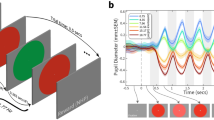Summary
Using operant conditioning methods, the pigeon's wavelength discrimination abilities were assessed in two experiments to generate discrimination functions. Both these functions showed three minima at 460, 530 and 595 nm. In the second wavelength discrimination experiment, extending measurements into the UV spectral region, pigeons also maintained good discrimination between wavelengths within the UV range tested. A fourth minimum was indicated at the lower end of the spectral range tested (365–385 nm). The results point to the complexity of the pigeon's chromatic system, which must be at least tetrachromatic, probably pentachromatic.
Similar content being viewed by others
Abbreviations
- S+:
-
positive stimulus
- S−:
-
negative stimulus
References
Blough, D.S.: Spectral sensitivity in the pigeon. J. Opt. Soc. Am.47, 827–833 (1957)
Blough, P.M.: Wavelength generalization and discrimination in the pigeon. Percept. Psychophys.12, 342–348 (1972)
Bowmaker, J.K.: The visual pigments, oil droplets and spectral sensitivity of the pigeon. Vision Res.17, 1129–1138 (1977)
Bridges, C.D.B.: Visual pigments of the pigeon (Columba livia). Vision Res.2, 125–137 (1962)
Delius, J.D.: Colour preference shift in hungry and thirsty pigeons. Psychon. Sci.13, 273–274 (1968)
Delius, J.D., Emmerton, J.A.: Visual performance of pigeons, in: Neural mechanisms of behavior in the pigeon. Granda, A.M., Maxwell, J.H. (eds.). New York: Plenum Press 1979
Delius, J.D., Perchard, R.J., Emmerton, J.A.: Polarized light discrimination by pigeons and an electroretinographic correlate. J. Comp. Physiol. Psychol.90, 560–571 (1976)
Donner, K.O.: The spectral sensitivity of the pigeon's retinal elements. J. Physiol. (London)122, 524–537 (1953)
Emmerton, J.A., Schwemer, S., Muth, I., Schlecht, P.: Spectral transmission of the ocular media of the pigeon (Columba livia). Invest. Ophthalmol. Visual Sci. (in press)
Galifret, Y.: Discussion. In: Mechanisms of colour discrimination. Galifret, Y. (ed.), pp. 116–117. London: Pergamon Press 1960
Galifret, Y.: Rétinotopie au niveau tectal et réponses spectrales diencéphaliques chez le pigeon. In: Neurophysiologie und Psychophysik des visuellen Systems. Jung, R., Kornhuber, R. (eds.), pp. 212–215, Freiburger Symposion. Berlin, Göttingen, Heidelberg, New York: Springer 1961
Govardovskii, V.I., Zueva, L.V.: Visual pigments of chicken and pigeon. Vision Res.17, 537–543 (1977)
Graf, V., Norren, D.V.: A blue sensitive mechanism in the pigeon retina: λmax 400 nm. Vision Res.14, 1201–1209 (1974)
Granda, A.M., Yazulla, S.: The spectral sensitivity of single units in the nucleus rotundus of pigeon.Columba livia. J. Gen. Physiol.57, 363–384 (1971)
Hamilton, W.F., Coleman, T.B.: Trichromatic vision in the pigeon as illustrated by the spectral hue discrimination curve. J. Comp. Psychol.15, 183–191 (1933)
Ikeda, H.: The spectral sensitivity of the pigeon (Columba livia). Vision Res.5, 19–36 (1965)
Jitsumori, M.: Wavelength discrimination function derived from post discrimination gradients in the pigeon. Jpn. Psychol. Res.20, 18–28 (1978)
Kreithen, M.L.: Sensory mechanisms for animal orientation — can any new ones be discovered? In: Animal migration, navigation, and homing. Schmidt-Koenig, K., Keeton, W.T. (eds.), pp. 25–34. Berlin, Heidelberg, New York: Springer 1978
Kreithen, M.L., Keeton, W.T.: Detection of polarized light by the homing pigeon,Columba livia. J. Comp. Physiol.89, 83–92 (1974)
Martin, G.R., Muntz, W.R.A.: Retinal oil-droplets and vision in the pigeon (Columba livia). In: Neural mechanisms of behavior in the pigeon. Granda, A.M., Maxwell, J.H. (eds.). New York: Plenum Press 1979
Norren, D.V.: Two short wavelength sensitive systems in pigeon, chicken and daw. Vision Res.15, 1164–1166 (1975)
Riggs, L.A., Blough, P.M., Schafer. K.L.: Electrical responses of the pigeon eye to changes in wavelength of the stimulating light. Vision Res.12, 981–991 (1972)
Schneider, B.: Multidimensional scaling of colour differences in the pigeon. Percept. Psychophys.12, 373–378 (1972)
Sears, F.W., Zemansky, M.W.: University physics: Part 2. Reading, Mass.: Addison-Wesley 1964
Shepard, R.N.: Approximation to uniform gradients of generalization by monotone transformation of scale. In: Stimulus generalization. Mostofsky, D.I. (ed.), pp. 94–110. Stanford: University Press 1965
Valois, R.L. De, Jacobs, G.H.: Primate colour vision. Science162, 533–540 (1968)
Wald. G.: The Selig Hecht commemorative lecture. Nat. Phys. Lab. Symp., No.8, 7–61 HMSO, London 1958
Wright, A.A.: Psychometric and psychophysical hue discrimination functions for the pigeon. Vision Res.12, 1447–1464 (1972a)
Wright, A.A.: The influence of ultraviolet radiation on the pigeon's colour discrimination. J. Exp. Anal. Behav.17, 325–337 (1972b)
Wright, A.A., Cumming, W.W.: Colour naming functions for the pigeon. J. Exp. Anal. Behav.15, 7–17 (1971)
Yazulla, S., Granda, A.M.: Opponent-colour units in the thalamus of the pigeon (Columba livia). Vision Res.13, 1555–1563 (1973)
Yoshizawa, T.: The behaviour of visual pigments at low temperatures. In: Handbook of sensory physiology, Vol. VII/1. Dartnail, H.J.A. (ed.), pp. 146–179. Berlin, Heidelberg, New York: Springer 1972
Author information
Authors and Affiliations
Additional information
We thank the technical staff of the Psychology Department at Durham University for their assistance and. in particular, Mr. D. Harper who collected some of the data in the second experiment. Mrs. C. Thompson gave us much helpful advice about the computer programming. The work was, in part, supported by an SRC Research Grant to J.D. Delius; J. Emmerton received a Durham University Research Studentship. The paper was prepared while the authors were supported by the Deutsche Forschungsgemeinschaft through its Sonderforschungsbereich 114.
Rights and permissions
About this article
Cite this article
Emmerton, J., Delhis, J.D. Wavelength discrimination in the ‘visible’ and ultraviolet spectrum by pigeons. J. Comp. Physiol. 141, 47–52 (1980). https://doi.org/10.1007/BF00611877
Accepted:
Issue Date:
DOI: https://doi.org/10.1007/BF00611877




